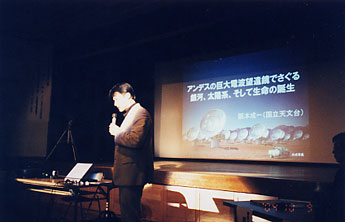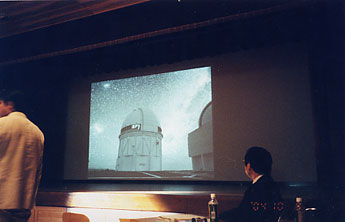|
• October 27
It is clear tonight. Though it is full moon, I came to the
observatory, as I am a little concerned about the fate of C/2004 R2 (ASAS).
The comet may have disappeared during its approach to the sun.
Mercury, brighter than 0 magnitude, was shining in the red
evening glow 30 minutes after the sunset. I was awestruck by its brightness
and beauty. It was the first time that I had seen Mercury so bright in
an almost day-like sky. I mistakenly thought it was a light of an airplane
which had taken off from Kochi Ryoma Airport.
It is a holiday season now and unfortunately they were playing
soccer (sandlot soccer?) at a sports field at the foot of the observatory.
This lit up the western sky and the 60cm telescope was unable to capture
the comet supposedly glowing at 8th magnitude. A 3-minute exposure completely
fogged up the film. At any rate C/2004 R2 has undoubtedly diminished to
a great extent.
While listening to the car radio on my way home, I heard
that two bears were found at Ikeda-cho in Tokushima Prefecture. It is a
rather unusual occurrence in Shikoku. The border areas between Kochi and
Tokushima Prefectures are deep in the tall mountains and the appearance
of bears is not surprising. Experts say that there are more than 10 Asiatic
black bears living there. Geisei Observatory is closer to Tokushima Prefecture
than to Kochi City and a mere thought of that black beast I had encountered
being a bear made me shiver. I have witnessed the black beast twice.
Incidentally I liked to trek alone around Miune near the
prefectural border and deep in the mountains of Iya, where the defeated
Heike Clan members were said to live. It was the area where a huge snake
more than 5 meters long was witnessed 30 years ago. I am scared of climbing
mountains alone because of a possible encounter with such a dangerous animal.
I reminisce dearly about my younger days. I would walk mountain paths alone
silently while dreaming about nothing but discovering a new comet. Even
now I only think about comets when I walk along the mountain roads. Occasionally
I hit upon a great idea during a simple mountain walk.
• October 18
Mr. Mano from Goto Optical Manufacturing Company visited
the observatory for a regular inspection of the 60cm telescope and a three-day
operation started. Goto Optical is among the top optical companies such
as Nikon and Mitaka. Their repair and maintenance work is excellent and
they always provide comprehensive care. Goto now specializes in planetarium
equipment but they look after any of their products very well regardless
of the time of manufacture, while there are some companies which charge
more with inferior maintenance work.
The 60cm had a problem of irregular motion in RA but this
was fixed by decreasing the fast slewing speed by a small amount. It uses
an IC more than 20 years old and there is no replacement motherboard available.
Because radical changes will cost a lot, we scavenge for parts for temporary
repairs. Soon or later, however, time may come to have it overhauled. It
means CCDs with a new drive system.
I saw some cherry blossoms at Sakuragaoka Park at the foot
of the observatory. There were just a few blossoms, which may have bloomed
thanks to the recent unusually warm weather. As soon as Typhoon No.23 (Tokage)
has left, autumn activity at the observatory will begin in earnest.
• October 13 (The frightening night at the observatory)
The weather has improved at last but the sky was somewhat
hazy and transparency was not quite good. On the night of the 11th I was
annoyed by clouds all night, but once clear patches between clouds had
spread, the starry sky looked stunningly beautiful. During the predawn
search that night I was able to capture galaxies in Leo near the edge of
the eyepiece field, which was usually difficult at low altitudes. Tonight,
however, the sky condition was so bad that 9.5-magnitude galaxies were
only barely visible even at the center of the field. In a condition like
this the zodiacal light, a typical scene of an autumn sky, was faintly
visible sharing the sky with the Milky Way.
When I was watching meteors, a dark beast (?) sprang out
of the bush in the darkness with loud thuds. "Bear!" I rushed
back into the dome. There might be some wild boars around but bears should
be rare. Shikoku is generally not such a dangerous place, but the forests
in Geisei are scary. You never know what comes out of the forests.
I tracked the glow of P/2004 R3 (LINEAR-NEAT) for 30 minutes
at midnight but the results might have been affected by fogging of film.
The total magnitude of the comet was 19.2!
Past midnight, C/2004 Q1 (Tucker) was at 10.3 magnitude visually and C/2004
Q2 (Machholz) was 8.3 magnitude in the 20cm scope at 60x. Both were easily
visible sporting faint tails.
On my way home I looked into the dark thickets along the
mountain path leading to the parking lot, but could not see any glaring
eyes.
I haven't talked about "the mystery of a comet seeker"
for a while, but will explore its roots by examining the recently-found
plan of this mysterious Zeiss comet seeker, which will become the final
episode of this series.
• October 9
There was an astronomical lecture meeting at the community hall
of Tosa-cho in Kochi featuring the vast expanse of the universe and dreams
about the future.
The lecturer was Prof. Seiichi Sakamoto, assistant professor
at the National Observatory. His talk was about the large radio telescope
called ALMA, which is expected to begin operation in the Andes in 2012.
It is a joint project by Japan, North America and Europe. Prof. Sakamoto
described the project and its significance very clearly and in a comprehensible
manner. Eight years from now a huge array of radio telescopes will be completed
in the Andes mountains at an altitude of 5000 meters and exploration of
the far reaches of the universe will begin. Prof. Sakamoto has been passionate
in opening the new frontier of astronomy beyond the capability of Subaru
Telescope and Hubble Space Telescope by capturing distant young galaxies.
I found it significant and surprising that such a lecture was given in
a small village in Tosa (Kochi) as the one which reports on the frontline
of astronomical work, thanks to the efforts of Tosa-born Prof. Shigemitsu.
There is an often-quoted saying: "Liberty originates in the mountains
of Tosa." If lectures like this one are often given in this area in
the future (there was one last year, too), some day the mountains of Tosa
may produce promising astronomers.
During the lecture they showed the slides of the starry sky
over the Andes, its nature and landscape, which were nothing short of breathtaking.
Stars shining in the dark sky over the 5000-meter-high Andes mountains
were equally bright whether at the zenith or on the horizon. Local residents
in that area, I heard, created constellations with the images of birds
and beasts, which were holes formed by dark nebulae, projected against
the intensely bright Milky Way. I held my breath when I was shown the extraordinary
glows of the Large and Small Magellanic Clouds over the observatories and
the awesome waterfalls of light of the Milky Way passing between the two
domes(Photograph 2). I heard that up there you could drive at night only
by starlight. I remember that when we drove up to 4200-meter-high Mauna
Kea 5 years ago our driver drove along without lights.
I wish I could observe where there is no light pollution.
|


